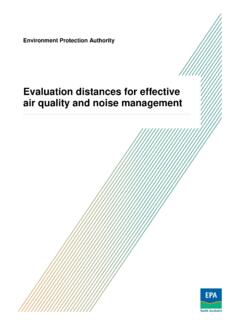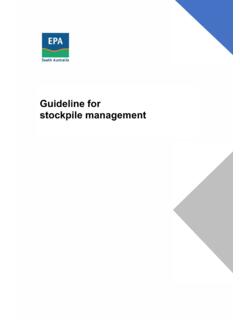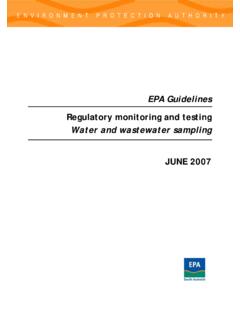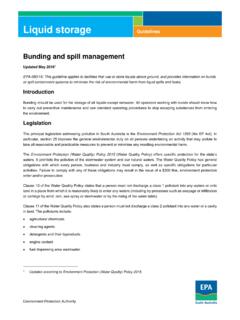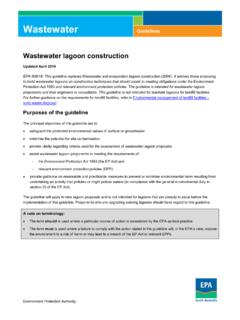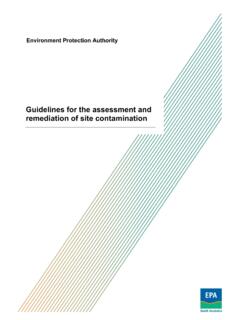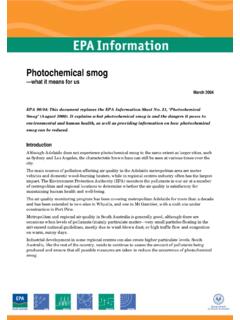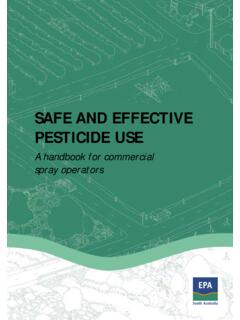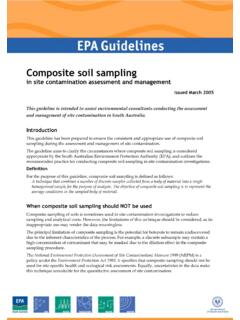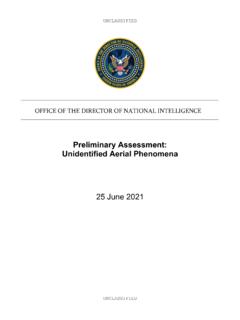Transcription of Waste Guidelines - EPA
1 Waste Guidelines Waste definitions Updated April 2019. EPA 842/19: This guideline provides definitions for a range of terms commonly used within the Waste industry. It also reflects changes included in the Environmental management of landfill facilities solid Waste disposal (2019), which incorporates the following definitions of landfill' and suitably qualified consultant'. Introduction Almost all the definitions have been sourced from Environment Protection Authority (EPA) licences, existing publications, legislation and Australian Standards. The remainder are the result of modifications to standard terminology to ensure clarity and relevance, or were developed based on recommendations from an industry reference group. This publication will be applied by the EPA in developing new licences, licence conditions and Guidelines . Existing licences will be progressively updated to reflect the new definitions. Definitions Term Definition Asbestos The fibrous form of mineral silicates belonging to the serpentine and amphibole groups of rock- forming minerals, including actinolite, amosite (brown asbestos), anthophyllite, chrysotile (white asbestos), crocidolite (blue asbestos), tremolite, or any mixture containing one or more of the mineral silicates belonging to the serpentine and amphibole groups.
2 Asbestos-containing material is any, material, object, product or debris that contains asbestos. Friable asbestos means: a non-bonded asbestos fabric, or b asbestos-containing material that: i is in the form of powder, or ii can be crumbled, pulverised or reduced to powder by hand pressure when dry. Non-friable asbestos means asbestos-containing material in which the asbestos fibres are bonded by cement, vinyl, resin or other similar material, eg asbestos cement. Asbestos Waste means Waste asbestos-containing material (ACM) including all removed ACM, as well as disposable items used during asbestos removal work, such as plastic sheeting and disposable coveralls, respirators and cleaning rags. Environment Protection Authority Waste definitions Term Definition Advice on the requirements for handling and transport of this Waste can be found in EPA. Guideline, Wastes containing asbestos: removal, transport and disposal. See also Approved codes of practice under the Work Health and Safety Act 2012.
3 Basel Convention The Basel Convention on the Control of Transboundary Movements of Hazardous Wastes and their Disposal. Adopted in Basel, Switzerland on 22 March 1989. Biodegradable Capable of being decomposed by the action of biological processes Biosolids Stabilised organic solids derived totally or in part from wastewater treatment processes that can be managed safely to utilise beneficially their nutrient, soil conditioning, energy, or other value. The term biosolids does not include untreated wastewater sludges, industrial sludges or the product produced from the high temperature incineration of sewage sludge. It should also be noted that many other solid Waste materials are not classified as biosolids eg animal manures, food processing or abattoir wastes, solid inorganic wastes and untreated sewage or untreated wastes from septic systems/sullage wastes. Building or Construction and Demolition Waste (Inert). Demolition Waste Cleaner Continuous use of maintenance management practices and technologies used in the production manufacture of products and provision of services resulting in more efficient use of resources (including energy) and the reduction of Waste and risk to the environment.
4 Clinical and Medical Waste Related Waste Commercial and Commercial and Industrial Waste (General). Industrial Waste The solid component of the Waste stream arising from commercial, industrial, government, (C&I). public or domestic premises (not collected as Municipal Solid Waste ), but does not contain Listed Waste , Hazardous Waste or Radioactive Waste . Commercial and Industrial Waste (Listed). The solid component of the Waste stream arising from commercial, industrial, government, public or domestic premises (not collected as Municipal Solid Waste ), that contains or consists of Listed Waste . Compost Pasteurised material resulting from the controlled microbiological transformation of compostable organic Waste under aerobic and thermophilic conditions for at least six weeks. Compostable The biodegradable component of the Waste stream that is of biological origin but does not Organic Waste contain any Listed Waste , Radioactive Waste or Hazardous Waste .
5 Notes: These organic materials may be processed through composting works to formulate valuable recycled organic products. Suitability of compostable organic Waste as feedstock is dependent on the location, site design, processes and potential to cause environmental harm. 2. Waste definitions Term Definition Composting The controlled process whereby compostable organic wastes are pasteurised and microbiologically transformed under aerobic and thermophilic conditions for a period not less than six weeks, including the pasteurisation phase. Construction and Construction and Demolition Waste (inert). Demolition Waste The solid inert component of the Waste stream arising from the construction, demolition or (C&D). refurbishment of buildings or infrastructure but does not contain Municipal Solid Waste , Commercial and Industrial Waste (General), Listed Waste , Hazardous Waste or Radioactive Waste . Notes: C&D Waste (Inert) should be such that the entire composition of the C&D materials is Inert Waste with no contamination by foreign material.
6 As such it is acknowledged that with the aim of no contamination there may be some negligible components of foreign material contained in the Waste (as a guide, 0 5% maximum by volume per load). C&D Waste (Inert). includes bricks, concrete, tiles and ceramics, steel and inert soils. foreign material includes green Waste , plastics, electrical wiring, timber, paper, insulation, tins, packaging and other Waste associated with construction or demolition of a building or other infrastructure. foreign material must not be Municipal Solid Waste , Liquid, Listed, Hazardous or Radioactive Waste . Construction and Demolition Waste (mixed). The solid component of Waste stream arising from the construction, demolition or refurbishment of buildings or infrastructure which contains some foreign material (as set out below), but does not contain Municipal Solid Waste , Commercial and Industrial Waste (General), Listed Waste , Hazardous Waste or Radioactive Waste .
7 Notes: C&D Waste is considered C&D Waste (Mixed) if it contains significant foreign materials from construction and demolition activities that would render the load of Waste no longer inert (as a guide, 5 25% maximum by volume per load). foreign material includes green Waste , plastics, electrical wiring, timber, paper, insulation, tins, packaging and other Waste associated with construction or demolition of a building or other infrastructure. foreign material must not be Municipal Solid Waste , Liquid, Listed, Hazardous or Radioactive Waste . Where Waste from construction and demolition sites contains predominantly foreign materials or domestic Waste , such as Waste from household clean ups collected by commercial skip bins, this is defined as Commercial and Industrial Waste (General). Controlled Waste Waste as defined in the National Environment Protection (Movement of Controlled Wastes between States and Territories) Measure 1998. Disposal Final stage in the management of Waste , which includes: treatment of Waste prior to disposal incineration of Waste , with or without energy recovery deposit of Waste to land or water discharge of liquid Waste to sewer permanent, indefinite or long-term storage of Waste .
8 3. Waste definitions Term Definition Note: Long-term storage of Waste includes Waste stored for a period of time that is not considered temporary by the EPA, whether for a defined period or not, and for which there is no known or foreseeable market for resource recovery. Dispose To dispose of Waste , including the deposit of Waste and causing or allowing Waste to be disposed or deposited. Domestic Waste Means the Waste produced in the course of a domestic activity. Dry Cleaning The Waste generated by dry cleaning activities (chemical or organic). Residues Encapsulation A process that creates a structure that completely surrounds sealed containers of Waste by concrete or another solid material approved in writing by the EPA, to reduce the likelihood of the formation of leachate by physically limiting water from contacting the Waste or the container. E- Waste Waste electrical and electronic equipment that is dependent on electric currents or electromagnetic fields in order to function (including all components, subassemblies and consumables which are part of the original equipment at the time of discarding).
9 For example e- Waste may include: a Consumer/entertainment electronics (eg televisions, DVD players and tuners). b Devices of office, information and communications technology (eg computers, c telephones and mobile phones). d Household appliances (eg fridges, washing machines and microwaves). e Lighting devices (eg desk lamps). f Power tools (eg power drills) with the exclusion of stationary industrial devices. g Devices used for sport and leisure including toys (eg fitness machines and remote control cars). Extended An environmental policy approach where the producers' responsibility, physical and/or producer financial, for a product is extended to the post-consumer stage of a product's life cycle. responsibility Notes: (EPR). Producers accept their responsibility when they design their products to minimize life cycle impacts and when they accept legal, physical and/or economic responsibility for the environmental impacts that cannot be eliminated by design.
10 A primary function of EPR is the transfer of the costs and/or physical responsibility (full or partial) of Waste management away from local government authorities and the general taxpayer to that of the producer. EPR can be government driven via regulation or through voluntary initiatives whereby producers take responsibility for managing the end-of-life aspects of their products. 4. Waste definitions Term Definition Flammable The range of a gas or vapour concentration that will burn or explode if an ignition source is (explosive) range introduced. Lower explosive limit (LEL): The lowest concentration of a gas in air (% of volume) that will ignite. Upper explosive limit (UEL): The highest concentration of a gas in air (% of volume) that will ignite. Green Waste The vegetative portion of the Waste stream arising from various sources including Waste from domestic and commercial premises and municipal operations. Hazardous Waste Listed Waste having a characteristic described in schedule A list 2 of the National Environment Protection (Movement of controlled Waste between States and Territories) Measure.
